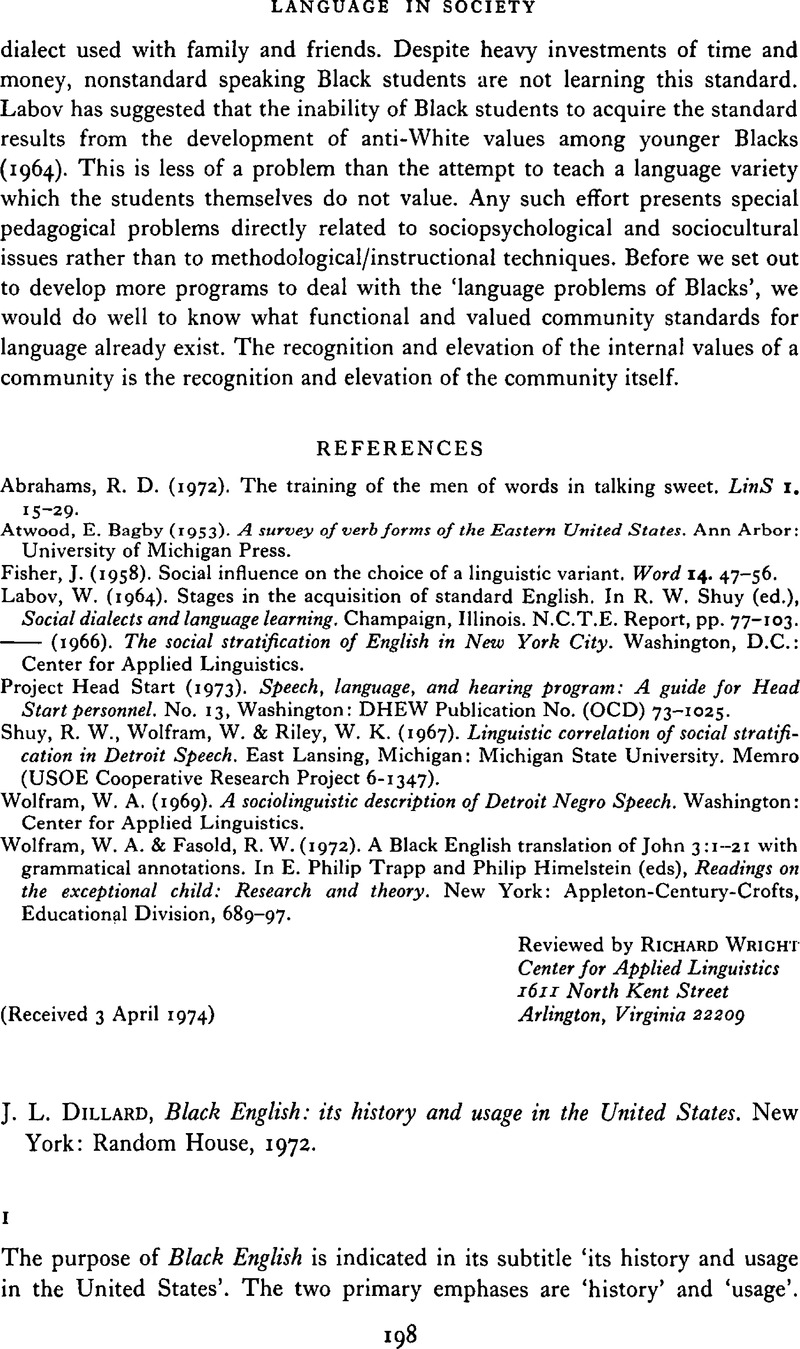No CrossRef data available.
Article contents
J. L. Dillard, Black English: its history and usage in the United States. New York: Random House, 1972.
Review products
J. L. Dillard, Black English: its history and usage in the United States. New York: Random House, 1972.
Published online by Cambridge University Press: 18 December 2008
Abstract
An abstract is not available for this content so a preview has been provided. Please use the Get access link above for information on how to access this content.

- Type
- Book Review
- Information
- Copyright
- Copyright © Cambridge University Press 1975
References
REFERENCES
Botkin, B. A. (1945). Lay My Burden Down: A Folk History of Slavery. Chicago: University of Chicago Press.Google Scholar
Demers, R. (1973). Review of Dillard, J. L., Black English: Its History and Usage in the United States. The Harvard Educational Review 43. 303–8.Google Scholar
Fasold, R. W. (1971). Minding your Z's and D'z: Distinguishing syntactic and phonological variable rules. In Papers from the Seventh Regional Meeting of the Chicago Linguistic Society. Chicago: Chicago Linguistic Society, 360–7.Google Scholar
Fasold, R. W. (1972 a). Decreolization and autonomous language change. The Florida FL Reporter 10. 1, 2. 9ff.Google Scholar
Fasold, R. W. (1972 b). Tense Marking in Black English. Arlington, Virginia: Center for Applied Linguistics (Urban Language Series, 8).Google Scholar
Fasold, R. W.Bins, C., Skopek, L., Tully, B. & Louis, C. (1973). Influences on Social Lect Level: Where You Are and Where Your Head Is. Paper presented at the Ninth Meeting of the South-eastern Conference on Linguistics.Google Scholar
Ferguson, C. A. (1964). Baby talk in six languages. American Anthropologist 66. 6 (Part 2): 103–14.Google Scholar
Ficket, J. G. (1970). Aspects of Morphemics, Syntax, and Semology of an Inner-City Dialect (Merican). West Ruch, New York: Meadowood Publications.Google Scholar
Hackenberg, R. (1972). A Sociolinguistic Description of Appalachian English. Unpublished Ph.D. dissertation. Georgetown University.Google Scholar
Herman, S. R. (1961). Explorations in the social psychology of language choice. Human Relations 14. 149–64.CrossRefGoogle Scholar
Hockett, C. F. (1950). Age-grading and linguistic continuity. Language 26. 449–57.CrossRefGoogle Scholar
Labov, W. (1969). Contraction, deletion and inherent variability of the English copula. Language 45. 715–62.CrossRefGoogle Scholar
Labov, W.Cohen, P., Robins, C., and Lewis, J. (1968). A Study of the Non-Standard English of Negro and Puerto Rican Speakers in New York City, Volume 1. USOE Final Report, Research Project No. 3288.Google Scholar
Lambert, W. E. & Tucker, G. R. (1967). White and Negro listeners' reactions to various American-English dialects. Social Forces 47. 463–8.Google Scholar
Leaverton, L. (1973). Dialect Readers: Rationale, Use, and Value, in Language Differences: Do They Interfere?, edited by Laffey, James L. and Shuy, Roger W.. Newark, Delaware: International Reading Association, 114–26.Google Scholar
Reisman, K. (n.d.) contrapuntal conversations in anAntiguan village. Penn-Texas Working Papers in Sociolinguistics, No. 3.Google Scholar
Schegloff, E. A. (1968). Sequencing in conversational openings. American Anthropologist 70. 1075–95.Google Scholar
Shuy, R. W. (1969). Bonnie and Clyde tactics in English teaching. The Florida FL Reporter 7. 1. 81ff.Google Scholar
Shuy, R. W.Baratz, J. C. & Wolfram, W. (1969). Sociolinguistic Factors in Speech Identification.NIMH Final Report, Project No. MH 15048–01.Google Scholar
Silverstein, M. (forthcoming). Dynamics of recent linguistic contact, Handbook of North American Indians, Vol. 16, Language (In press.)Google Scholar
Sledd, J. (1969). Bi-dialectalism: The linguistics of White supremacy. English Journal 58 1307–29.CrossRefGoogle Scholar
Sledd, J. (1972). Doublespeak: Dialectology in the service of Big Brother. College English 33. 439–56.Google Scholar
Spears, M. K. (1972). Review of Dillard, J. L., Black English: Its History and Usage in the United States. The New York Review of Books (11 16, 1972).Google Scholar
Stewart, W. A. (1969). The use of Negro dialect in the teaching of reading, in Teaching Black Children to Read, Edited by Baratz, Joan C. and Shuy, Roger W.. Washington, D.C.: Center for Applied Linguistics (Urban Language Series 4), 156–219.Google Scholar
Wolfram, W. (1969). A Sociolinguistic Description of Detroit Negro Speech. Washington, D.C.: Center for Applied Linguistics (Urban Language Series, 5).Google Scholar
Wolfram, W. (1971) Sociolinguistic alternatives for teaching reading to speakers of Nonstandard English. The Reading Research Quarterly 6. 9–33Google Scholar
Wolfram, W. (1974) Sociolinguistic Aspects of Assimilation: Puerto Rican English in New York City. Arlington, Virginia: Center for Applied Linguistics (Urban Language Series, 9).Google Scholar
Wolfram, W. (Forthcoming.) The relationship of Southern White speech to vernacular Black English. To appear in Language.Google Scholar
Wolfram, W.Wolfram, W. & Fasold, R. W. (1974). The Study of Social Dialects in American English. Englewood Cliffs, New Jersey: Prentice-Hall, Inc.Google Scholar


